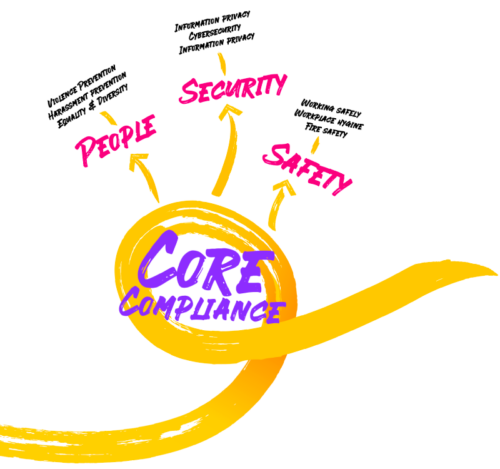Build a Compliance Training Program: Start with the Basics
When it comes to creating a compliance training program, mastering the fundamentals is not just a choice – it’s the cornerstone of success.
If you’re managing the launch or overhaul of your organization’s compliance training strategy, you might be feeling a bit overwhelmed. Between the complexities of your industry’s changing compliance standards, the requirements set out by your country’s regulatory bodies, the goals of your business, and the needs of your employees, your compliance training program has a lot of moving parts to consider.
Let’s make compliance training easier by starting with the basics. In this article, you’ll learn how to build your core compliance training program from three fundamental principles, and you’ll explore the solutions to some of the most common compliance training pitfalls.
Creating a Compliance Positive Culture
It’s common for L&D to be landed with the task of managing the compliance training program. When this happens, it’s also common for L&D professionals to feel out of their depth. It’s no wonder – compliance training is often mentioned in the same sentence as audits, breaches, violations, litigation, risks, and threats. Scary stuff!
The best compliance training addresses so much more than laws, rules, and risk mitigation, though – it lays the foundation for a positive, safe, and ethical workplace culture. It’s used to prevent all the horrors listed above, which makes it a positive part of modern work life. Keeping this in mind can help you adopt positive perspective on compliance throughout the planning and training process, which can make all the difference in how this compliance training is received by leadership and employees alike.
People, Safety, and Security
A simple way to approach your company’s compliance training strategy is focusing on your people, their safety, and your organization’s security. Despite business becoming more complex and unpredictable, these three fundamentals are consistent across most businesses and affect most employees. They should be at the core of your compliance program.
If you are embarking on a process of establishing a compliance training program for the first time or reviewing a program that’s already in place, you can use Litmos’ Core Compliance Model below to ensure that you have the fundamentals covered:
Let’s break down the Core Compliance Model, starting with PEOPLE. We’re not saying that the three topics in the model are the only compliance training your teams need, but this content will cover the foundational skills that all employees need to treat each other fairly and with respect. In many jurisdictions there are also legal requirements to train employees in these core topics.
Next, we’ll explore SAFETY. Again, the topics included in this portion of the model aren’t the only ones that an organization should include in their compliance training. However, all the topics listed are critical for keeping anyone in a physical workspace – like a lab, factory floor, or warehouse – safe from injury.
Lastly, your organization’s SECURITY compliance training may be far more expansive than the topics listed in this model, depending on your industry and region. But any effective core compliance training program would be incomplete without some mention of cybersecurity, information privacy, and social media.
Combatting Compliance Pitfalls
Once you’ve identified the compliance topics that address your organization’s people, safety, and security concerns, consider the challenges that you may face in the distribution, monitoring, and reporting of your compliance program.
Here are the a few of the most common challenges companies face when implementing a compliance training program, and how you can address them:
1. Lack of Employee Engagement with Compliance Training
Lack of employee engagement is a common challenge for company-wide compliance training. When employees find compliance training dull or irrelevant, participation and retention suffer. This can lead to costly errors and potential legal, financial, and reputational repercussions for the organization.
Litmos’s Compliance Training Made Easy Guide details 10 key methods used by L&D leaders to improve employee engagement. Providing clear objectives, making learning relevant to job functions, making modules easily accessible (online and offline, desktop or mobile), and gamifying training are just a few ways that you can boost learner engagement for your compliance program.
2. Limited Resources for Compliance Training
Compliance training can be time-consuming and costly when your company lacks proper resources. In SAI’s 2023 Healthcare Compliance Benchmark Report, 55% of survey respondents said that compliance demands surpassed available resources. This is critical as compliance training ensures adherence to laws, reducing risks of violations and associated harm.
Consider leveraging an online training platform that offers off-the-shelf compliance courses, automation features, and administrative support to reduce the strain on your resources. Litmos offers a huge library of pre-built compliance content, so that your L&D team can focus on driving learning results.
3. Lack of Consistency in Compliance Training
Consistency is critical for compliance training, to ensure that all employees across an organization receive the same level of training and have a firm grasp of their responsibilities and the consequences of non-compliance. Inconsistency in training may lead to disparate interpretations of rules and regulations and, thus, more opportunities for costly errors.
Using standardized, centralized learning materials and implementing an employee-wide onboarding program can ensure a more consistent compliance training approach. Offering refresher trainings can also keep employees more up to date on compliance information, regardless of when they were hired.
Our Compliance Training Made Easy Guide includes exclusive insights on how to leverage Litmos tools to provide continuous training to employees and improve learner retention, while overcoming common challenges that HR and L&D professionals face when implementing compliance training.
Don’t Just “Check the Box”
When you started reading this article, you might have thought we were going to convince you that you can create a one-size-fits-all compliance training program. While there are ways to make the planning, execution, and assessment of your compliance programs easier, it’s important to remember that compliance training is so much more than a “check the box” activity. By using the Core Compliance Model discussed above, you can align your trainings with your company’s people, safety, and security, and take a critical step toward influencing real, positive change for your employees and your business.
Ready to stop stressing about compliance training and build a more positive compliance culture through continuous learning? Litmos’s Compliance Training Made Easy Guide includes expert L&D insights and real-world compliance success stories to provide you with best practices for building your own employee compliance training program. Download your guide today.





